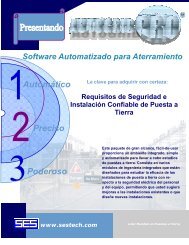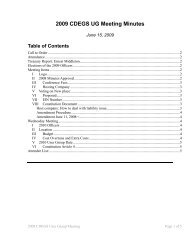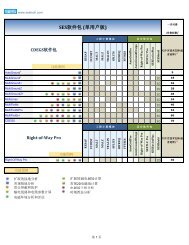download
download
download
- No tags were found...
Create successful ePaper yourself
Turn your PDF publications into a flip-book with our unique Google optimized e-Paper software.
A Software Tool that Automates the Selection<br />
of Soil Structures that Apply<br />
During Winter or EarlySpring Seasons<br />
In regions where the top layer soil can freeze during winter or<br />
dry out during summer it is necessary to assess the effects of<br />
shallow depth resistivity variations on the grounding design.<br />
The recent internationally approved IEC<br />
standard 619361 entitled Power Installations<br />
Exceeding 1 kV ac – Part 1: Common<br />
Rules, states clearly in Section 10.3.1<br />
General Clause b:<br />
Determine the (grounding) zone of interest.<br />
If not a global earthing system<br />
(meaning an urban zone), then determine<br />
the soil characteristics of the<br />
zone of interest, taking into account<br />
the seasonal variation of the soil parameters.<br />
This requirement means that the designer<br />
of a grounding system has the<br />
obligation to determine if seasonal soil<br />
resistivity variations have an impact<br />
on the grounding performance.<br />
Overview of SoilModelManager<br />
It is well known that soil resistivity increases dramatically when the temperature drops below zero<br />
degrees Celsius. The resistivity can increase by a factor of 51000 times the “summer” value, depending<br />
on the temperature, soil material type, moisture content, salinity etc. What resistivity scaling<br />
factors should be used for the various top soil layers that are affected by the temperature in a given<br />
geographical region when soil freezes? Some have argued that a factor of 5 to 6 would be an adequate<br />
average. Others prefer to use a value on the order of 20 or more. The best approach is not to<br />
try to use an average value but to<br />
emulate the real distribution of resistivity<br />
with depth as a function of the temperature<br />
at that depth.<br />
This is what SoilModelManager does,<br />
taking into account the unfrozen<br />
(summer) soil model and other relevant<br />
information such as meteorological data<br />
as provided by the user. It uses resistivity<br />
scaling factor curves corresponding to<br />
the soil type under study to automatically<br />
generate the appropriate soil models for<br />
the winter and early–spring seasons,<br />
based on the unfrozen soil model.<br />
www.sestech.com<br />
World Leader in Grounding & EMI





